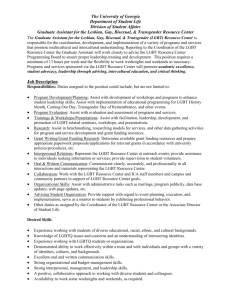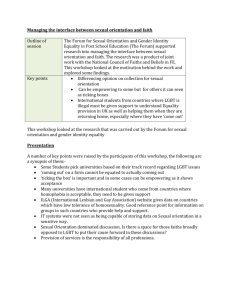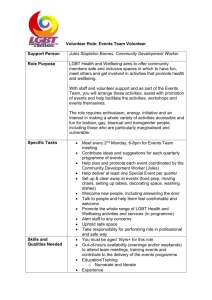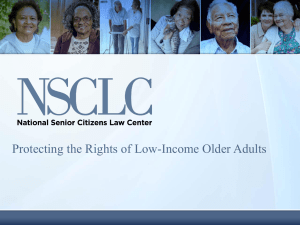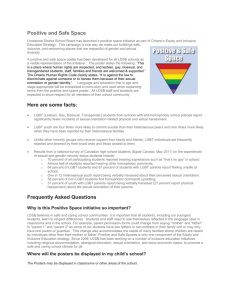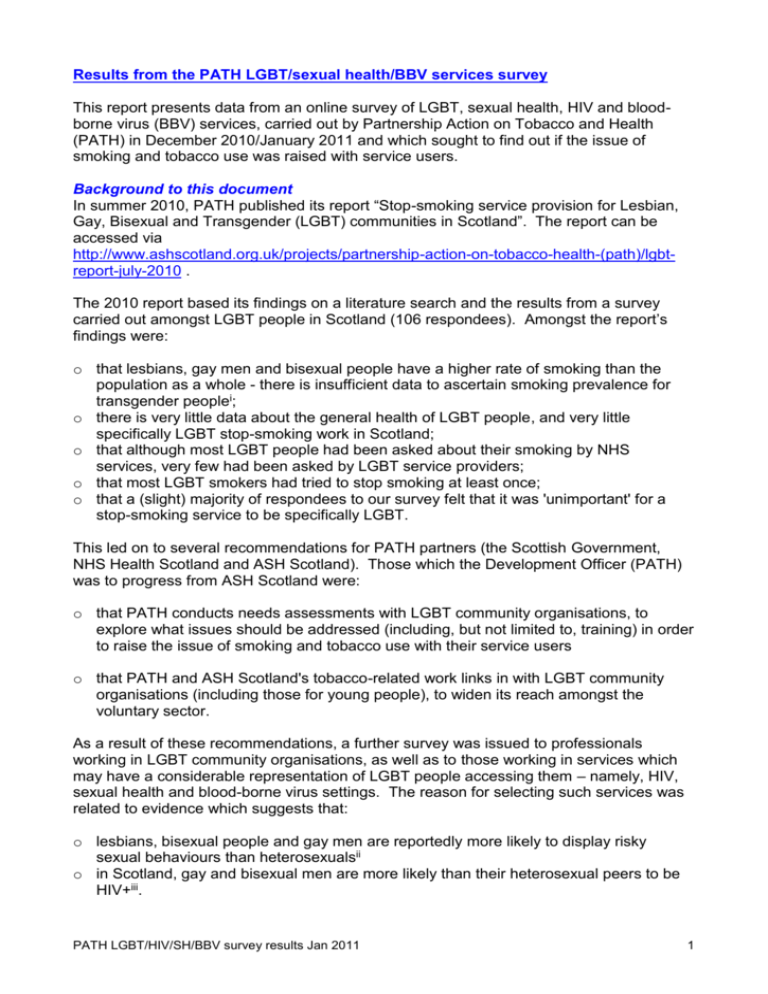
Results from the PATH LGBT/sexual health/BBV services survey
This report presents data from an online survey of LGBT, sexual health, HIV and bloodborne virus (BBV) services, carried out by Partnership Action on Tobacco and Health
(PATH) in December 2010/January 2011 and which sought to find out if the issue of
smoking and tobacco use was raised with service users.
Background to this document
In summer 2010, PATH published its report “Stop-smoking service provision for Lesbian,
Gay, Bisexual and Transgender (LGBT) communities in Scotland”. The report can be
accessed via
http://www.ashscotland.org.uk/projects/partnership-action-on-tobacco-health-(path)/lgbtreport-july-2010 .
The 2010 report based its findings on a literature search and the results from a survey
carried out amongst LGBT people in Scotland (106 respondees). Amongst the report’s
findings were:
o that lesbians, gay men and bisexual people have a higher rate of smoking than the
population as a whole - there is insufficient data to ascertain smoking prevalence for
transgender peoplei;
o there is very little data about the general health of LGBT people, and very little
specifically LGBT stop-smoking work in Scotland;
o that although most LGBT people had been asked about their smoking by NHS
services, very few had been asked by LGBT service providers;
o that most LGBT smokers had tried to stop smoking at least once;
o that a (slight) majority of respondees to our survey felt that it was 'unimportant' for a
stop-smoking service to be specifically LGBT.
This led on to several recommendations for PATH partners (the Scottish Government,
NHS Health Scotland and ASH Scotland). Those which the Development Officer (PATH)
was to progress from ASH Scotland were:
o that PATH conducts needs assessments with LGBT community organisations, to
explore what issues should be addressed (including, but not limited to, training) in order
to raise the issue of smoking and tobacco use with their service users
o that PATH and ASH Scotland's tobacco-related work links in with LGBT community
organisations (including those for young people), to widen its reach amongst the
voluntary sector.
As a result of these recommendations, a further survey was issued to professionals
working in LGBT community organisations, as well as to those working in services which
may have a considerable representation of LGBT people accessing them – namely, HIV,
sexual health and blood-borne virus settings. The reason for selecting such services was
related to evidence which suggests that:
o lesbians, bisexual people and gay men are reportedly more likely to display risky
sexual behaviours than heterosexualsii
o in Scotland, gay and bisexual men are more likely than their heterosexual peers to be
HIV+iii.
PATH LGBT/HIV/SH/BBV survey results Jan 2011
1
Distribution of the survey
This second survey was issued electronically by various means in late 2010:
o to known LGBT/HIV/sexual health voluntary organisations around Scotland;
o via the Wellbeing In Sexual Health (WISH) newsletter, issued to over 2,500 sexual
health practitioners;
o from the Scottish Government’s tobacco directorate to NHS Executive Directors for
sexual health, NHS sexual health strategy leads, NHS sexual health promotion leads,
NHS sexual health lead nurses, NHS HIV Executive Leads, the West of Scotland
sexual health network and the national sexual health and HIV advisory committee;
o via the CHEX (Community Health Exchange) e-bulletin;
o via the VHS (Voluntary Health Scotland) e-bulletin;
o via the SREN (Scottish Rural Equality Network) online forum message boards.
Survey results
Thirty-five participants started the survey and 25 completed it. The breakdown of
responses to each question is detailed below (number of respondees in brackets).
Employment status
Most people who responded to the survey were in full-time employment:
o
o
o
o
full-time paid
part-time paid
volunteer
other
(26)
(4)
(4)
(1)
The one ‘other’ respondee was retired.
Main geographical area worked in
Respondees worked or volunteered across Scotland:
o
o
o
o
o
o
o
o
o
o
o
o
o
o
o
o
Lothian
Highland
Ayrshire & Arran
Greater Glasgow & Clyde
Fife
Scotland-wide
Dumfries & Galloway
Lanarkshire
Argyll & Bute
Borders
Forth Valley
Grampian
Tayside
Western Isles
Orkney
Shetland
(8)
(5)
(4)
(4)
(3)
(3)
(2)
(2)
(1)
(1)
(1)
(1)
(1)
(1)
0
0
PATH LGBT/HIV/SH/BBV survey results Jan 2011
2
Main client base for respondees’ service/organisation:
Respondees were asked to identify the main client base for their service or organisation:
o
o
o
o
o
o
o
o
o
o
o
o
o
o
the whole population (youth and adult; may include LGBT people) (12)
other
(4)
LGBT adults specifically
(3)
young people (may include LGBT) under 25
(3)
LGBT young people specifically (under 25)
(3)
gay men
(2)
a specific racial/ethnic sub-set of the population (may include LGBT people from
that racial/ethnic group)
(1)
adult males (may include gay/bisexual/trans men)
(1)
bisexual people
(1)
men who have sex with men (not identifying as gay or bi)
(1)
lesbian women
0
transgender people
0
adult females (may include lesbian/bisexual/trans women)
0
the general adult population (may include LGBT people)
0
For those who ticked ‘other’, their client base was identified as:
o older people (1)
o people living with, or at high risk of, HIV infection (1)
o men involved in prostitution (1)
o people from Africa (1).
Main focus of respondees’ service/organisation:
Respondees were asked to identify the main focus of their service or organisation; the
following answers were given:
o providing services, support or information specifically to members of the LGBT
population, including young LGBT people
(12)
o providing specific blood-borne virus services - including testing and treatment for
HIV or hepatitis - support or information to the whole population (may include
LGBT people)
(11)
o providing general sexual health services - including testing and treatment for
STIs - support or information to the whole population (may include LGBT
people)
(10)
o providing general health promotion services to the whole population (may
include LGBT people)
(8)
o providing stop-smoking support to the whole population (may include LGBT
people)
(5)
o other
(5)
o none of the above
(1)
Those who ticked ‘none of the above’ or ‘other’ stated that they were/provided:
o second-tier support to agencies, along with direct support to the public with
targeted health information (2)
o school teacher (1)
o worker at a young peoples’ sexual health drop-in service (1)
o development worker with older people (1)
o signposting to testing and treatment for HIV and hepatitis (1).
PATH LGBT/HIV/SH/BBV survey results Jan 2011
3
Raising the issue of smoking/tobacco use with clients
When asked if their service/organisation asked clients/service users about their smoking or
tobacco use, most people did so:
o yes (22)
o no (7)
o don’t know (1)
Advice given by those who do raise the issue
A range of advice was given by those services/organisations who do raise the issue of
smoking or tobacco use with clients:
o
o
o
o
o
o
o
o
o
o
to contact their local NHS stop-smoking service
to seek further help from their GP
to seek further help from a pharmacist
to seek further help from a hospital-based stop-smoking service
to seek support from a phone line (e.g. Smokeline)
to make a quit attempt on their own
other
to seek support online (e.g. www.canstopsmoking.com)
to seek further help from their local health centre (not GP)
to seek further help from an addictions service
(16)
(13)
(10)
(8)
(8)
(8)
(8)
(6)
(4)
(4)
For those who responded ‘other’, they gave the following advice:
o we occasionally run stop-smoking groups, so would refer to those if running at
that time (2)
o to consider why they might wish to make a quit attempt, e.g. effect on fertility,
HPV etc. (1)
o if requested, provide a cessation service prior to the sexual health drop-in which
is in a youth provision building (1)
o brief advice to stop smoking, but if they’re not ready to stop now they can come
back (1)
o we have trialled in house stop smoking services including for LGBT groups but
suffered from poor attendance (1)
o [refer on to] voluntary HIV agency, where [such] services exist (1)
Why services/organisations don’t raise the issue
Of the seven respondees who stated that they (or their organisation) didn’t raise the issue
of smoking or tobacco use with clients/service users, the following reasons were given:
o I/we don't think it's appropriate that we ask/raise the issue at the point we're
seeing our clients
(3)
o I/we don't think it's relevant to our clients
(2)
o I/we don't know how to appropriately raise the issue
(2)
o I/we don't know enough about smoking/tobacco use to raise the issue (2)
o it's not what we're funded to do
(2)
o by raising the issue I/we are concerned about endangering the provider/client
relationship
(2)
o other
(2)
o don't know
(1)
PATH LGBT/HIV/SH/BBV survey results Jan 2011
4
o some of our staff/volunteers are smokers so might feel hypocritical about raising
the issue
0
o I/we don't have the time to raise the issue
0
Those who ticked ‘other’ gave the following reasons:
o other areas of health improvement and health promotion tend to take
precedence (1)
o there is a lot to talk about in a consultation, and clients cannot be expected to
respond to too many issues at once (1).
Opportunities for raising the issue of smoking/tobacco use
Respondees were asked to identify current opportunities (whether they were used or not)
for raising the issue with clients:
o
o
o
o
o
o
o
o
leaflets displayed on site
(20)
one-to-one consultations/assessments with service users/clients (17)
posters displayed on site
(16)
group sessions with service users/clients
(12)
specific awareness-raising sessions delivered to all service users (11)
discussion forums for service users/clients
(9)
peer support groups
(5)
other
(2)
Those who ticked ‘other’ suggested these additional opportunities for raising the issue:
o web-based info and sign-posting (3)
o using the skills and knowledge of the voluntary sector to promote and work in
partnership with local NHS stop-smoking services (1)
o cessation service attends the youth centre if requested (1)
o opportunistic discussion in informal settings (1)
Enabling services/organisations to raise the issue of smoking/tobacco use
When asked to identify what might be provided in order to help services and organisations
raise the issue of smoking/tobacco use with clients/service users, the following responses
were given:
o information (e.g. leaflets, weblinks) for staff/volunteers about smoking/tobaccorelated health risks and the benefits of stopping
(17)
o resources (leaflets etc.) to give to clients/service users (16)
o more money to enable staff/volunteers to be trained
(15)
o training for staff/volunteers on how to raise the issue of smoking/using tobacco
with clients
(15)
o clear evidence base around specific risks for HIV, BBV (14)
o awareness-raising sessions for staff/volunteers about smoking/tobacco-related
health issues
(12)
o other
(2)
o none of the above
(1)
PATH LGBT/HIV/SH/BBV survey results Jan 2011
5
Those who ticked ‘other’ suggested these additional enablers for raising the issue:
o more management support for raising the issue awareness/training sessions to
encourage staff/volunteers to attend (1)
o more money to pay staff to do group sessions (1)
o resource and time to do the above (1)
o targeted smoking cessation intervention/support services for minority groups (1)
Training already accessed for raising the issue of smoking/tobacco use
Respondees were asked to identify what training they had already accessed which might
enable them to raise the issue of smoking or tobacco use with clients/service users:
o I've not attended any training which enabled me to raise the issue of
smoking/tobacco use
(11)
o inequalities training (LGBT-specific or otherwise) which included raising the
issue of addiction
(7)
o addictions training
(6)
o local NHS stop-smoking training
(6)
o other training
(6)
o youth work training which included raising the issue of addiction (3)
o PATH/Glasgow Caledonian University academically-accredited stop-smoking
training
(2)
o Maudsley stop-smoking training
(2)
Those who ticked ‘other’ had received the following training:
o presentation [of the PATH report] at GayCon highlighted smoking within the
LGBT community and made me consider the issue for the first time
(1)
o attended the [PATH] session delivered at GAYCON which re-energised me into
thinking again about brief interventions regarding stop smoking advice.
Previously had worked in settings where this was asked at each consultation sometimes hard to remain motivated without evidence base to show whether
this works or not
(1)
o Smokey Joe training (1)
o health promotion/counselling skills/brief interventions/motivational interviewing
(1)
o training provided by NHS Lothian on raising the issue of smoking and facilitating
Stop-Smoking Groups targeted at the LGBT community
(1)
Barriers to attending training
Respondees were asked to identify what (if any) barriers might exist in their locality, which
may prevent them (or colleagues) attending training for raising the issue of smoking or
tobacco use:
o no barriers exist that I am aware of
(11)
o it's not part of our core remit/service
(7)
o lack of time (too busy to attend)
(7)
o lack of funding (organisation can't afford costs, inc. providing backfill) (6)
o no management support for sending people on such training
(2)
o I don't know if such training currently exists
(2)
o other reason
(4)
o I don't think training like this is relevant to what I do
(1)
o such training doesn't exist in my local area
(1)
PATH LGBT/HIV/SH/BBV survey results Jan 2011
6
Those who ticked ‘other’ identified these additional barriers to attending training:
o school children (secondary) have no interest in attending such groups (1)
o we already raise the subject routinely, but if training was a requirement it would
be lack of time/money, and staff indifference
(1)
o think that there needs to be LGBT specific training - especially as there are often
specific reasons for LGBT people to smoke such as bullying, exclusion,
domestic abuse, etc.
(1)
o most youth workers who support our service are only employed for a few hours
a week and it’s very difficult for them to be released for training
(1)
o no training offered for non-NHS staff to deliver support services/groups (1)
o there are many issues we have to raise and be trained on so only a proportion of
time can be devoted to one interest area
(1)
Final additional comments
Respondees were invited to leave any final additional comments in relation to raising the
issue of smoking with LGBT people and/or HIV/sexual health/BBV service users:
o I would certainly be interested to know if there was a genuine connection
between being gay and being a smoker
(1)
o this topic has not been highlighted to local stop smoking services or attention
drawn to how we would engage or ensure service options are available. This
area needs certainly needs developed further
(1)
o LGBT young people have often stated that they smoke because they are bullied
at school, because they want to look older in order to access bars etc. when
they are young to meet other LGBT people, because they are socially excluded
and also because their peer groups smoke
(1)
o all health staff should be offered specific support to stop smoking themselves (1)
o I think you have underestimated the degree to which many services including
LGBT services and specifically HIV care services already address smoking (1)
o we have a specific problem in offering group support, in that our Articles and
funding permit us to offer services only to gay and bisexual men. This can be
problematic in having sufficient numbers at any one time. In the past we have
overcome this by working in partnership with another LGBT organisation to offer
group sessions to LGBT people. This is something I'd like to explore again in
future
(1)
o could the survey also consider the effects of smoking among the diverse groups
of people living with HIV i.e. not just gay men?
(1)
Conclusions
o low response rate (including for LGBT organisations), so difficult to draw firm
conclusions or make strong recommendations
o some services, but not all, do already ask about clients’ smoking status
o issues around raising the issue and/or attending training relate to capacity,
attitude, knowledge/skills (several respondees stated that they had received no
training to help them raise the issue, although an equal number believe that
there are no barriers to attending training)
o signposting and/or providing information online (both in the voluntary sector and
in NHS settings) could help improve links between services (LGBT, sexual
health and stop-smoking)
PATH LGBT/HIV/SH/BBV survey results Jan 2011
7
o there appears to be scope for better and closer ties between NHS stop-smoking
services and voluntary/community organisations which support LGBT people,
e.g. by displaying leaflets/posters of the other’s services.
Focus group volunteers
Of the 25 respondees to the survey, 8 people stated that they would be happy to
participate in a future focus group. Discussions from the focus groups will be detailed in a
separate document, to be issued later in 2011.
Linda Bates
Development Officer (PATH)
January 2011
Opportunities for raising the issue of smoking and tobacco use
i
NHS Health Scotland/ScotPHO. 2010. Dimensions of diversity: population differences and
health improvement opportunities. Edinburgh: NHS Health Scotland. Available online at:
http://www.scotpho.org.uk/home/Publications/scotphoreports/pub_diversityreport.asp
[accessed 09.12.10]
ii
as above
ISD Scotland. 2009. Scotland’s Sexual Health Information Report 2009. Edinburgh: ISD Scotland.
Available online at: http://www.isdscotland.org/isd/6062.html [accessed 09.12.10]
iii
PATH LGBT/HIV/SH/BBV survey results Jan 2011
8

